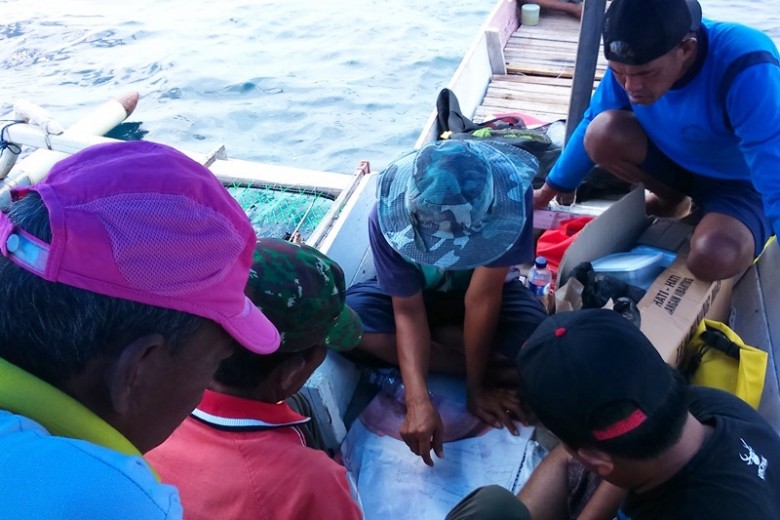
Villagers of Bungaiya on Selayar, Indonesia, researching the best location, size and number of MPAs.
Selayar village advances its MPA plans
September 20 2017
Villagers of Bungaiya on Selayar, Indonesia, have joined with a CCRES Marine Protected Area (MPA) design expert to help them confirm the best location, size and number of their existing and planned MPAs. Community-declared MPAs are an important part of Selayar communities’ management arrangements for their respective waters, alongside customary rules about fishing gear and times.
In July, social scientists Dr Dedi Adhuri, Mr Ali Yansyah Abdurrahim and Prof Helen Ross teamed up with marine and fisheries scientist Dr Nils Krueck to participate in a collaborative process with the people of Bungaiya village using CCRES tools. It is an example of CCRES scientists collaborating across their core areas of expertise, and with local users, in order to increase the potential impact of their research.
“On the first day, we went to Bungaiya and showed the community what MPA design tools we have at CCRES and how they can be used,” said Nils. “After that we put up a gridded map of their area and some butcher’s paper so we could capture everyone’s input on where they go to fish, what they fish, how much they fish and which candidate areas for protection they had in mind.” In this process they decided the issues they would like Nils to help them explore.
The community then nominated a local team of divers to go out into the region’s coastal waters with Nils and a local member of the social science team, Ibu Andi Rismayani, in order to survey all candidate MPA sites and their surroundings. Other team members including Ibu Andi Ismainna assisted from boats. Following in-depth discussions with community members about local fisheries during and after each day in the field, Nils then processed all data, ran his optimization models, and went back to discuss findings for alternative MPA design scenarios with the community.
“In a nutshell, we found that there were very few degraded areas along the coastal reef that seemed unworthy of protecting, and we therefore encouraged the community to strictly enforce their first candidate MPA,” said Nils. “We then used CCRES tools to highlight that larger than initially planned MPAs are likely to benefit fish population recovery, and we also encouraged them to prioritise at least one MPA in northern community waters given that dominant ocean currents flow southwards. MPAs in northern areas are more likely to spread fish larvae in support of fish population recovery and potential catch increases in community waters that remain open to fishing.”
According to the social science team, which has been working with the villagers for seven months, the community had already established two small MPAs before Nils arrived, but they were not officially registered with the government.
“They wanted to check whether quantitative assessments based on CCRES tools would support their proposed MPAs, to see if the science agreed with their local knowledge and understanding, and to look at a wider range of options,” said Helen Ross.
“They have their own customary laws, but because they do not have full official status, if other villages encroach on their MPAs, they have difficulty enforcing them. If they get the MPAs officially recognised under government regulations, and have the further backing of science, it gives them more authority to protect the areas.”
One of the key factors that influenced the community’s choice of locations for MPAs was the ability to see them from the village so that they could easily enforce their protection. A northern MPA was more difficult to enforce with respect to this very practical criterion, but Nils encouraged villagers to explore all options given the likely value of MPAs in the north highlighted by his models.
“This was the first time I have been involved in participatory research with direct stakeholder input while I was running my analyses,” said Nils. “I definitely learned a lot. For example, you can have the best models to identify candidate sites for MPAs, but for this small community, MPAs need to be close to a settlement where they can be monitored and enforced. Anything else is secondary.”
This participatory approach of involving ‘end-users’ in the research process is key to the social science team’s work, as is the idea of ‘progressive adoption’ where communities are involved in all aspects of the research – not just sold an end-product.
Helen said that the social science team would have loved to have done the same work with Parak, another community on Selayar that they have been working with.
“What Nils did could have been done with many villages in the island, given resources,” she said. “Participatory research is very generalisable – it can be done anywhere you have interested communities and where the technical model used can be rescaled.”
More information
Nils Krueck
Helen Ross



